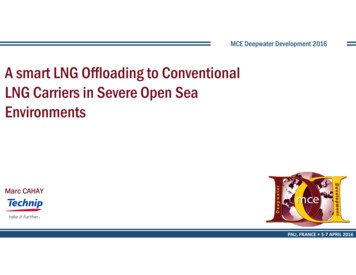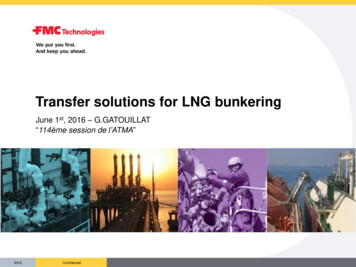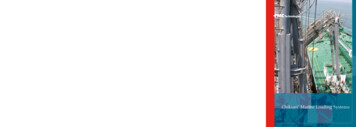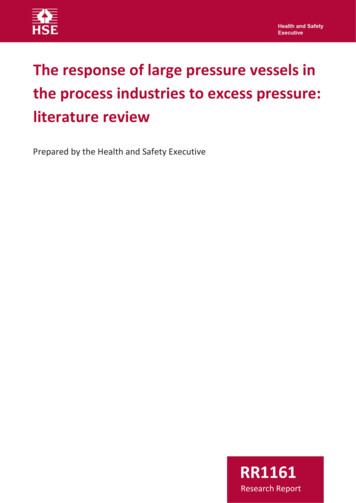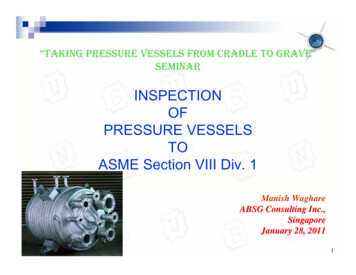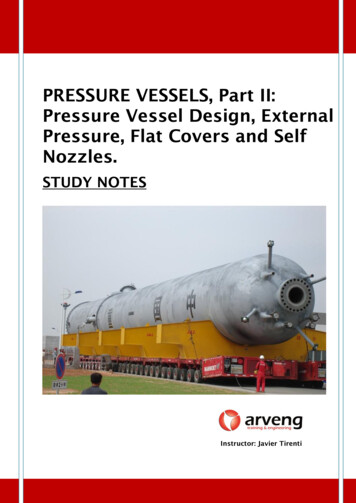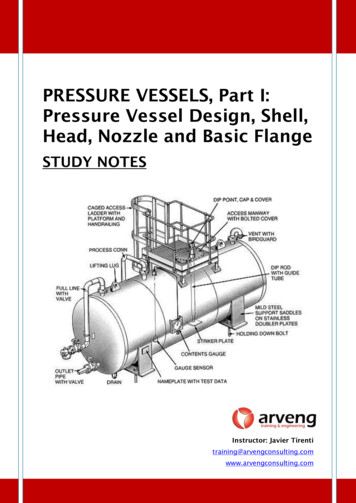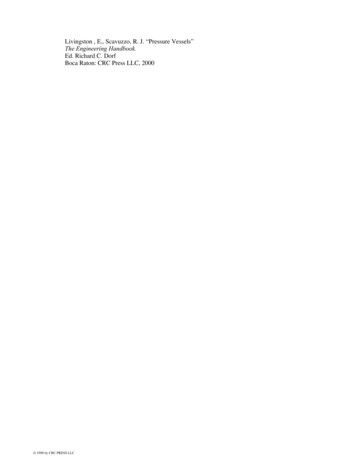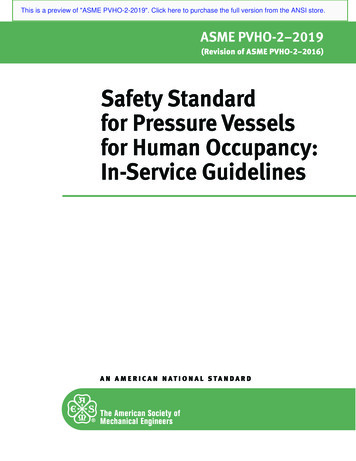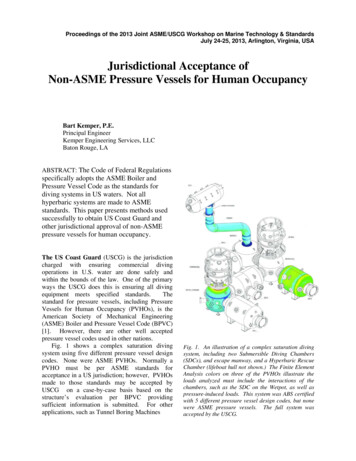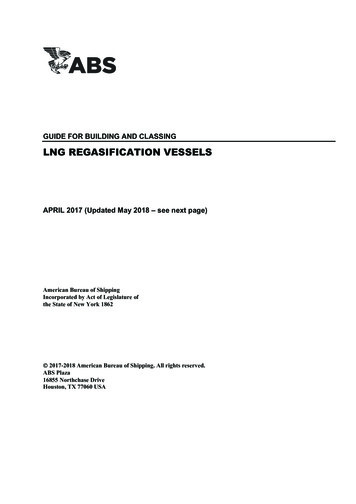
Transcription
Guide for Building and Classing Regasification VesselsGUIDE FOR BUILDING AND CLASSINGLNG REGASIFICATION VESSELSAPRIL 2017 (Updated May 2018 – see next page)American Bureau of ShippingIncorporated by Act of Legislature ofthe State of New York 1862 2017-2018 American Bureau of Shipping. All rights reserved.ABS Plaza16855 Northchase DriveHouston, TX 77060 USA
UpdatesMay 2018 consolidation includes: April 2017 version plus Notice No. 1
ForewordForeword (1 May 2018)The industry and ABS share a large and successful body of experience with Liquefied Natural Gas (LNG)carriers.This Guide provides criteria that can be applied to LNG Carriers and LNG Barges proposed to be classedby utilizing the ABS Rules for Building and Classing Steel Vessels, ABS Guide for Building and ClassingLiquefied Gas Carriers with Independent Tanks, and/or ABS Rules for Building and Classing Steel Bargesand fitted with regasification systems and components.Floating storage and regasification units (FSRUs) provide solutions to meet the energy demands of anever-changing global market. Floating regasification is a flexible, cost-effective way to receive and processshipments of LNG. Floating regasification is increasingly being used to meet natural gas demand in smallermarkets, or as a temporary solution until onshore regasification facilities are built. Floating regasificationinvolves the use of a specialized vessel often referred to as an FSRU, which is capable of transporting,storing, and regasifying LNG onboard. An FSRU can be purpose-built or be converted from a conventionalLNG vessel by installing a regasification plant.Regasification plants are installed to vaporize the liquid gas onboard a vessel, this may include selfpropelled LNG carriers or Non-Self-Propelled LNG barges. The gas may be delivered to the shore sidefacility via various arrangements, such as turret system with delivery through an offshore buoy pipingsystem or vessel manifold system to facility on platform, quay or similar.This Guide is to be used in conjunction with other ABS Rules and IMO Regulations.This Guide is for the use of designers, builders, owners and operators of liquefied gas carriers/tank bargesand specifies the ABS requirements for obtaining the optional classification notation (LNG) R.This Guide becomes effective on the first day of the month of publication.Users are advised to check periodically on the ABS website www.eagle.org to verify that this version ofthis Guide is the most current.We welcome your feedback. Comments or suggestions can be sent electronically by email to rsd@eagle.org.ABS GUIDE FOR BUILDING AND CLASSING LNG REGASIFICATION VESSELS . 2017iii
Table of ContentsGUIDE FOR BUILDING AND CLASSINGLNG REGASIFICATION VESSELSCONTENTSSECTION 1Scope and Conditions of Classification . 71Scope and Application .73Classification Notations.75Definitions .77Materials of Construction .89Certification .811Alternatives .8SECTION 2Vessel Arrangements and System Design . 91Application.93Plans and Data to be Submitted .95Risk Assessment .105.17Mooring .119Turret Compartment Arrangements .119.1Structural Fire Protection . 119.3Fire Propagation . 119.5Explosion or Uncontrolled High-pressure Gas Release . 1111Sloshing .1113Regasification System and Equipment .121513.1General . 1213.3Pressure Vessels . 1213.5Pumps . 1213.7Compressors . 1213.9Pressure Relief and Venting System . 1313.11Depressurization/Blowdown system . 1313.13Turret Compartment Transfer Systems . 13Electrical Systems and Installations .1415.117ivAssessment Criteria. 10Hazardous Areas . 14Fire Safety .1417.1Water Spray System . 1417.3Dry Chemical Powder Fire-extinguishing Systems . 1417.5Ventilation . 1517.7Fire Detection System . 1517.9Gas Detection System . 15ABS GUIDE FOR BUILDING AND CLASSING LNG REGASIFICATION VESSELS . 2017
SECTION 319Instrumentation and Control Systems. 1521Emergency Shutdown (ESD) System Control . 1623Cargo Operations Manuals . 16Surveys . 171Surveys During Installation and Trials . 1731.1Surveys During Installation . 171.3Surveys During Trials . 17Surveys After Construction and Maintenance of Class . 173.3Tail Shaft Surveys . 19ABS GUIDE FOR BUILDING AND CLASSING LNG REGASIFICATION VESSELS . 2017v
This Page Intentionally Left Blank
Section 1: Scope and Conditions of ClassificationSECTION11Scope and Conditions of ClassificationScope and Application (1 May 2018)This Guide has been developed to provide guidance for the design, construction, and survey of LiquefiedNatural Gas (LNG) vessels utilizing regasification systems. The Guide focuses on systems and arrangementsprovided for the safe delivery of natural gas by means of regasification systems. The Guide applies to LNGvessel types that fall under the scope of the IGC Code and associated ABS requirements for Vessels Intended toCarry Liquefied Gases in Bulk under Part 5C, Chapter 8 of the ABS Rules for Building and Classing SteelVessels (Steel Vessel Rules), the ABS Guide for Building and Classing Liquefied Gas Carriers withIndependent Tanks (LGC Guide), or the ABS Rules for Building and Classing Steel Barges (Barge Rules).In general, vessels are to comply with the requirements contained in the ABS requirements for Vessels Intendedto Carry Liquefied Gases in Bulk under Part 5C, Chapter 8 of the Steel Vessel Rules, the LGC Guide, or theBarge Rules, as applicable, and the requirements of this Guide to receive the notations listed in Subsection 1/3.This Guide applies to both new construction and existing vessel conversions, regardless of size, utilizingregasification systems.3Classification Notations (1 May 2018)Vessels that comply with this Guide and are intended to operate in a regasification and gas discharge role,are eligible for ABS classification which will be denoted with the additional notation (LNG) R, so that theclass notation as it appears in the Record will be:À A1 Liquefied Gas Carrier, (LNG) R or À A1 Liquefied Gas Tank Barge, (LNG) RÀ A1 Liquefied Gas Carrier with Independent Tanks, (LNG) R5DefinitionsThe definitions contained in 5C-8-1/2 of the Steel Vessel Rules are applicable. The following definitionsare applied to the terms used in this Guide:Cargo Machinery Spaces. The spaces where cargo compressors or pumps, cargo processing units, are located,including those supplying gas fuel to the engine-room.Floating Storage and Regasification Unit (FSRU). A vessel that has LNG storage as well as regasificationequipment for LNG vaporizing.Gas Process Unit. Booster pumps, process pressure vessel, regasification plant.Regasification Plant. All systems and components for removing liquefied gas from the storage tanks,pressurizing, heating and vaporizing liquefied gas and discharge ashore of vaporized gas through an off-loadingsystem. If there are compressors or odorizes in the discharge system, they would be considered part of theRegasification Plant.Turret Compartments. Those spaces and trunks that contain equipment and machinery for retrieval andrelease of the disconnectable turret mooring system, high-pressure hydraulic operating systems, fire protectionarrangements and cargo transfer valves.Upset Condition. Interruptions in the regular running of the work process or other planned activity. Anydistraction or break in the normal work routine is considered an Upset Condition.ABS GUIDE FOR BUILDING AND CLASSING LNG REGASIFICATION VESSELS . 20177
Section71Scope and Conditions of ClassificationMaterials of ConstructionMaterials in general are to comply with the requirements of the ABS Rules for Materials and Welding(Part 2).Materials used in gas tanks, gas piping, process pressure vessels, and other components in contact withcryogenic liquids or gases are to be suitable for the intended purpose and in compliance with Section 5C-8-6of the Steel Vessel Rules.9CertificationDesign review, survey, testing, and the issuance of reports or certificates constitute the certification ofmachinery, equipment and systems; see also 4-1-1/3 of the Steel Vessel Rules.11AlternativesEquipment, components, and systems for which there are specific requirements in this Guide, or its associatedreferences, may incorporate alternative arrangements or comply with the requirements of alternative recognizedstandards, in lieu of the requirements in this Guide. These alternative arrangements or standards are to bedetermined by ABS as being not less effective than the overall safety and strength requirements of thisGuide or associated references. Where applicable, requirements may be imposed by ABS in addition tothose contained in the alternative arrangements or standards so that the intent of this Guide is met. In allcases, the equipment, component or system is subject to design review, survey during construction, testsand trials, as applicable, by ABS for purposes of verification of its compliance with the alternativearrangements or standards. The verification process is to be to the extent as intended by this Guide.
Section 2: Vessel Arrangements and System DesignSECTION12Vessel Arrangements and System DesignApplicationThe requirements specified in this Section provide general guidance on ship arrangements and regasificationplant design.3Plans and Data to be SubmittedThe following regasification plant plans, calculations and information, as applicable, are to be submitted inaddition to those required by 4-1-1/5.3 and 5C-8-1/5 of the Steel Vessel Rules, as applicable: General arrangement of the regasification plant Hazardous area arrangement Booklet of installations in classified hazardous areas Risk assessment Operational manual Scantlings and details of foundation drawing in way of regasification and power generation modules Strength analysis document in way of regasification and power generation modules. Cargo containment and Pump Tower strength analysis (sloshing) Escape routes Project specification and overall process concept description Machinery arrangement of regasification plant and power generation system Ventilation system for compartment of cargo machinery space and turret, if applicable Cryogenic spill containment Failure Modes and Effects Analysis (FMEA) (As required by Subsection 2/19) Emergency shutdown (ESD) system ESD Cause and effect diagram Fire and gas detection and alarm systems Fire extinguishing systems Piping and Instrumentation Diagram (P&ID) Piping material specification Process Flow Diagram (PFD) Piping arrangement Pipe stress analysis (high pressure and cryogenic)ABS GUIDE FOR BUILDING AND CLASSING LNG REGASIFICATION VESSELS . 20179
Section52Vessel Arrangements and System Design Details of all cargo and vapor handling equipment including high pressure system Details and installation of the safety valves/blow down valves and capacity calculations Inert-gas system Pressure relief and blowdown calculations Mooring details and specification Regasification plant testing proceduresRisk AssessmentA risk assessment is to be submitted for ABS review per requirements in IGC Code 1.1.10.5.1Assessment CriteriaA risk assessment is to be carried out to identify significant hazards and accident scenarios that may affect theinstallation or any part thereof, and consider the benefit of existing or potential ris
Booster pumps, process pressure vessel, regasification plant. Regasification Plant. All systems and components for removing liquefied gas from the storage tanks, pressurizing, heating and vaporizing liquefied gas and discharge ashore of vaporized gas through an off-loading system. If there are compressors or odorizes in the discharge system, they would be considered part of the Regasification .File Size: 273KBPage Count: 19
